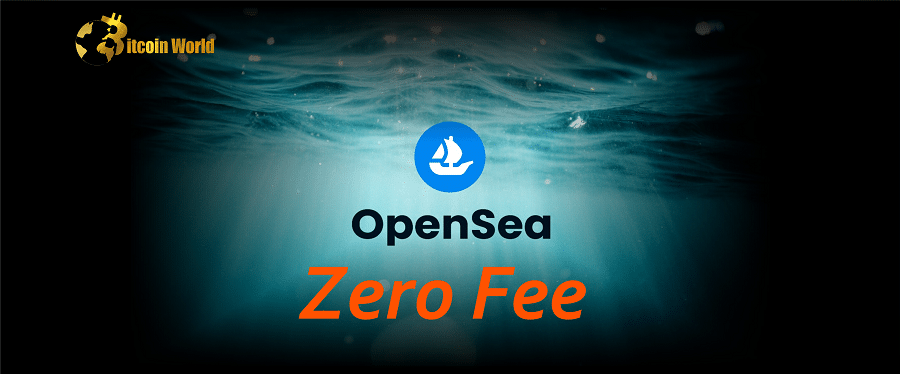The NFT world is buzzing with a major shake-up! In a dramatic turn of events, OpenSea, the reigning king of NFT marketplaces, has decided to scrap its marketplace fees. Why? To fiercely compete with the rising star, Blur, and its zero-fee model. Think of it as a high-stakes race to capture the lion’s share of the NFT market, but at what cost?
Why is OpenSea Suddenly Dropping Fees? The Blur Effect
For a while now, OpenSea has been the go-to platform for buying and selling NFTs. But a new challenger has emerged: Blur. Since its launch in October, Blur has been making waves with its zero-fee approach. This strategy has clearly started to bite into OpenSea’s market share, forcing the giant to react.
OpenSea itself acknowledged this competitive pressure in a recent tweet, stating:
“In October, we started to see meaningful volume and users move to NFT marketplaces that don’t fully enforce creator earnings. Today, that shift has accelerated dramatically despite our best efforts.”
This isn’t just a minor tweak; it’s a significant strategic shift. OpenSea is essentially saying, “If you can’t beat them, join them” – at least temporarily. They’re removing their marketplace fee to stay competitive and prevent users from migrating en masse to zero-fee platforms like Blur.
What Exactly Has OpenSea Changed?
Here’s a breakdown of OpenSea’s key changes:
- Temporary Fee Reduction: OpenSea has temporarily slashed its marketplace fee to 0%. Yes, you read that right – zero fees!
- Optional Creator Earnings: They’re making creator earnings optional, giving buyers the choice to pay royalties.
- Relaxing Blocklist Policy: OpenSea is also changing its stance on marketplaces that don’t fully enforce creator royalties. They will now allow trading on platforms like Blur, reversing their previous blocklist policy.
Blur vs. OpenSea: A Head-to-Head Market Battle
The competition between OpenSea and Blur is intensifying, especially with Blur launching its own cryptocurrency, BLUR, recently. Let’s take a quick look at how these platforms stack up:
| Metric | OpenSea | Blur |
|---|---|---|
| Marketplace Fee | 0% (Temporary) | 0% |
| Creator Royalties | Optional | Optional (with tools to enforce) |
| Weekly Volume (Feb 7-14) | 36,608 ETH (approx.) | 11,424 ETH (approx.) |
| Sales (Feb 15) | 19,908 | 12,185 |
While OpenSea still holds a larger weekly volume, Blur is rapidly closing the gap. On February 15th, Blur even surpassed OpenSea in daily trading volume for the first time, signaling a significant shift in the landscape.
Blur’s native token, BLUR, is also making waves. It debuted at $0.50 and, despite some volatility, has seen significant trading volume. At one point, its 24-hour trading volume reached a staggering $509 million, placing it among the top cryptocurrencies in terms of trading activity.
The Creator Royalty Conundrum: Who Wins, Who Loses?
The core of this battle extends beyond just marketplace fees; it’s deeply intertwined with the contentious issue of creator royalties. Royalties, a percentage of вторичных продаж that goes back to the NFT creator, were once considered a cornerstone of the NFT ecosystem. They were seen as a way for artists to earn continuous income from their work in the digital space, almost like a digital pension.
However, Blur champions a different approach, arguing for optional royalties. They even released a blog post urging creators to blocklist OpenSea to ensure they receive full royalties on Blur. This highlights a fundamental disagreement on how creator compensation should work in the NFT space.
The problem? As more platforms move towards optional or zero royalties, a “race to the bottom” scenario emerges. OpenSea themselves admitted that:
“Now, 80% of overall ecosystem volume does not pay full creator earnings, and the majority of the volume (even when inorganic activity is taken into account) has gone to a zero-fee environment.”
This raises critical questions:
- Is this a sustainable model for NFT creators? If royalties become optional and are often skipped, how will artists be fairly compensated for their work in the long run?
- Does this benefit collectors more than creators? Zero fees and optional royalties might attract collectors looking for cheaper trades, but could it disincentivize artists from creating NFTs if their earnings potential diminishes?
- What’s the future of NFT royalties? Will they become a relic of the past, or will the community find a way to ensure creators are fairly rewarded?
The Road Ahead: Navigating the Shifting NFT Landscape
OpenSea’s decision to drop fees is a clear sign of the intense competition in the NFT marketplace arena. While this might seem like a win for traders in the short term with reduced costs, the long-term implications for creators and the broader NFT ecosystem are still uncertain.
Here are some key takeaways to consider:
- Competition is good for innovation, but… While competition can drive platforms to improve and offer better services, a relentless focus on price wars might devalue the art and creativity at the heart of NFTs.
- Creator empowerment is crucial. The NFT space was built on the promise of empowering creators. Finding sustainable models that fairly compensate artists is essential for the long-term health of the ecosystem.
- The royalty debate is far from over. Expect continued discussions and experimentation around royalty structures and enforcement mechanisms. The community needs to decide what value it places on creator compensation.
The battle between OpenSea and Blur is more than just a marketplace skirmish; it’s a reflection of the evolving values and priorities within the NFT world. As this “race to the bottom” unfolds, it’s crucial to keep a close eye on how it impacts creators, collectors, and the future of digital art and ownership.
Disclaimer: The information provided is not trading advice, Bitcoinworld.co.in holds no liability for any investments made based on the information provided on this page. We strongly recommend independent research and/or consultation with a qualified professional before making any investment decisions.


